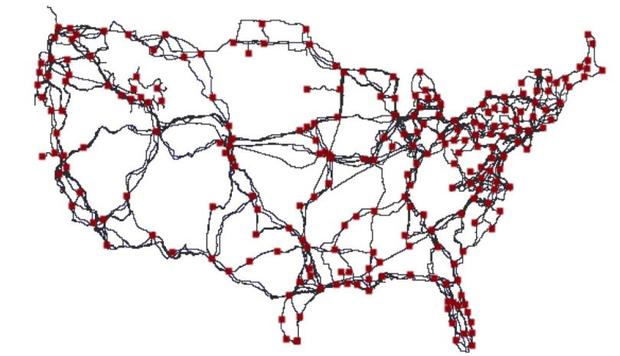A new map outlines the backbone of the U.S. Internet for the first time.
Researchers have been trying to create the map for about 20 years, but a team from the University of Wisconsin, Colgate University and the computer security company NIKSUN, finally made it happen. Computer scientist Paul Barford says the resulting report and map represent hours of painstaking work.
“The complexity of Internet infrastructure has gone well beyond what a single entity can actually understand today,” he said. “The map shows the first-of-its-kind representation of the long-haul links in the United States that make up the Internet.”
AT&T is the largest owner of Internet infrastructure in the United States. Other leading owners include Level 3, Sprint, and Windstream. Before this map was created, none of these providers knew where all of the conduits were buried.
Barford expects the diagram to help create a stronger, more secure and robust Internet. He also anticipates it will help the FCC make decisions on how to regulate the Internet, should its network infrastructure become public.

Image courtesy of University of Wisconsin/Paul Barford
The map’s release raises security concerns about whether it gives enemies of the United States, or enterprising hackers, a road map for disrupting the nation’s Internet.
“There’s always an ongoing question about security,” said Barford. “Do you want to be secure through the obscure? Or do you want to be secure by having information that people can use to make infrastructure in this case better?”
Barford and his team, working in cooperation with the U.S. Department of Homeland Security, chose the latter. To be on the safe side, the publicly-released map isn’t as detailed as it could be.
The intent in creating the map, Barford said, it to make things better, not worse.
“It gives us a platform for improving the Internet,” he said, “and for researchers to ask longer-term questions that potentially result in the Internet of the future that gives us features and functions and capabilities that young people are dreaming up right now.”
If the researchers have their way, with the backbone of the Internet already all mapped out, those dreams will come true just a little bit faster.


























Haven’t read the Barford paper yet so I dont know what it is really reporting, but this is certainly not the first time a map of the internet backbone has been published.
Actually on the nationwide network, the internet is just data. The nationwide network has been around for years, beginning as copper, then microwave and now largely as fiber.
The data superhiways don’t become internet data until it hits the ISP’s.
Although this isn’t the first time an internet backbone map was published, it is the best cross-referenced one I’ve found taking into account the ever-growing ISP lines and networks & the internet backbone provider maps. Even if we combined all the back bone numbers and maps of St. Louis data center I work for-http://www.cybercon.com/data-center-network, it wouldn’t be as clear and concise as this. I’m sure the full map is much more detailed and fully agreed shouldn’t be public for security, but is there any chance of release of an updated map coming, perhaps color-coded with the different major providers? It would be great to have a current edition of the map, especially with the changes that are happening with internet like relinquishing of ICANN and attempt at ending Net Neutrality, as this could affect how people host and route data and would be good to know for speed and reliability purposes.